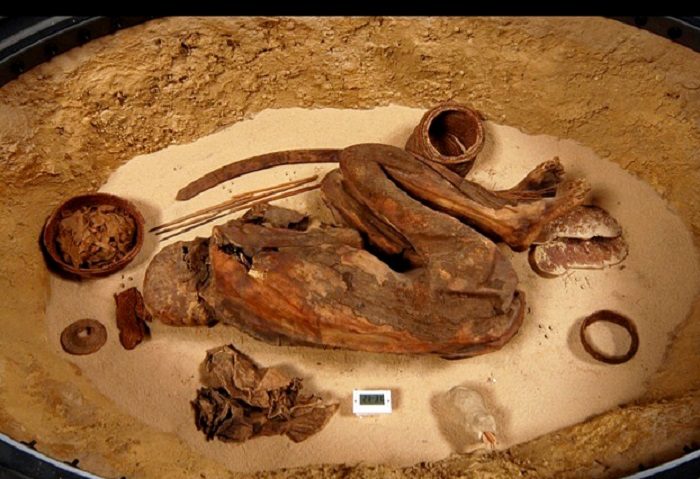
Using a range of investigatory techniques including chemical analysis, shotgun metagenomics, textile analysis and radiocarbon dating, a team led by Egyptologist Jana Jones from Macquarie University in Australia made the finding by examining "mummy S. 293" - the oldest preserved body held in the collection of the Turin museum in Italy.
Textile dating revealed that the mummy - acquired by the museum in 1901 from a dealer - had been interred around 3600 CE. The date places the event some 1000 years before the invention of writing and around 2500 years before the peak of Egyptian mummification practice, at the height of the pharaonic era.
Mummy S.93 was originally buried lying on his left side, curled in a foetal position, possibly clothed in a full-body shroud, and lain beneath a thin covering of earth. It was originally thought that the body's preservation had occurred through "natural mummification", in which the desiccating effects of sand and wind had prevented complete decomposition.
Detailed analysis of chemical residues present on the corpse itself, its funerary coverings, or the grave goods assumed to have been part of the original burial assemblage had never been conducted.
In part this is because in many cases such approaches are of limited value. A lot of prehistoric mummies held in museum collections for long periods of time were once treated with substances such as linseed oil to improve their appearance. Needless to say, this type of treatment is guaranteed to confound any attempts to detect any original coatings.
Mummy S.93, however, had never received any form of display augmentation, despite having been in Turin for more than a century. This represented a golden opportunity for Jones and her colleagues.
When the results were in, the scientists were surprised to find that the mummy had not been left to the tender drying mercies of the wind and sand. Instead it, and the textiles which surrounded it, had been carefully coated in a special "balm" - a mixture of preserving agents that comprised plant oil, conifer resin, an aromatic plant extract or balsam, and a sugar derived from plant gum.
The mixture represented a sophisticated combination of ingredients designed not only to preserve but also to prevent spoilage. In particular, some of the ingredients comprising the balsam, and the conifer resin, had strong antibacterial qualities. The resin came from a species not native to Egypt, and thus had to have been imported.
The ingredients, Jones and her colleagues write in the Journal of Archaeological Science, were typical in combination and proportion of "those employed by the Egyptian embalmers when their skill was at its peak, some 2500 years later".
Mummy S.93, and by implication other preserved bodies dating from the same period, "represent here the literal embodiment of the antecedents of classic mummification, which would become a central tenet of ancient Egyptian culture".



Reader Comments
The push-back of the extra 1500 years, won't it become more impossible for those who keep insisting that ancient Egyptians were White, to keep insisting that ancient Egyptians were White? Forgot Dr. Chiek Anta Diop, and when they unsuccessfully fought him as hard as they could have, to show that the mummies were White people. Forget that White people exited their caves approximately 3500 years, years after the mummies. I could go on and on. Yet there are those who insist that ancient Egyptians were White, so too the mummies, although Diop proved them all wrong with spare to thrash the next group.
Shalom
I think you need to remove the bone from your nose and go back to Kansas, George.